If you love snacking on nuts but don’t want to rely on store-bought varieties, consider growing your own nut trees! Some nut trees produce large green nuts that are perfect for harvesting right in your own backyard. In this article, we’ll explore some of the best options for trees with large green nuts that can thrive in many climates.
Shagbark Hickory
The shagbark hickory tree is one of the most common types of trees that has big green nuts. The tree is easy to spot because its bark is rough and peels off in big chunks. The eastern and central United States are home to the snagbark hickory. The nuts are covered in a thick green shell about the size of a golf ball that falls off the tree. When the nut is ready, the husk breaks open, letting it fall out.
Inside each green orb is a tasty, wild-harvested nut that tastes like a mix of walnut and pecan. The nuts are quite large, up to 2 inches long! However, shagbark hickory nuts have hard shells that make it labor intensive to extract the nutmeat. For the enterprising homesteader though, the sweat equity pays off in delicious, gourmet nuts straight from your backyard.
Shagbark hickory trees start producing nuts after about 6 years. They thrive in zones 4-9, even tolerating arid climates when irrigated. Plant your shagbark away from your garden beds since it releases a chemical that inhibits other plant growth.
Black Walnut
Another backyard nut tree with golf ball-sized green orbs is the black walnut. Inside the thick green husks are large, rough-shelled nuts with a bold, earthy flavor. The black walnut tree grows up to 100 feet tall and hails from the central and eastern United States. However, it tolerates a wide range of climates from zones 4-9.
Black walnut trees produce juglone a compound toxic to some plants, so avoid planting them in your vegetable or flower beds. They begin bearing nuts after about 7 years. You’ll know the nuts are ripe when their husks split open. The drooping limbs also lose many nuts simply from the impact of hitting the ground.
It takes patience and hard work to get the kernel out. Carefully crack the shell with a hammer or vise and then pick out the pieces. When you handle the husked nuts, wear gloves because they can stain your hands. The unique, rich walnut taste makes the work well worth it.
Butternut
Similar to black walnut but slightly smaller is the butternut tree It produces oval nuts nestled inside fuzzy green husks the size of a lime As the nuts ripen, the husks split open releasing the nuts. Butternut trees reach a mature height around 40-60 feet tall.
The nuts have a sweet buttery taste and smooth hard shells. Butternut thrives in zones 3-8 across the northeastern United States and southeastern Canada. Trees start yielding nuts after 4-6 years. Provide ample room since butternut trees also release juglone like black walnut and hickory.
Heartnut
Heartnut is actually a hybrid of Japanese walnut and butternut. As you may guess from the name, heartnut produces large, heart-shaped nuts encased in a solid green husk when immature. The husks split as the nuts ripen in the fall.
Inside is a thin-shelled nut with a mild, sweet flavor reminiscent of butternut. Heartnut trees reach 30-60 feet tall at maturity. They produce nuts just a few years after planting. Heartnut tolerates cold winters in zones 4-8.
While the nuts are smaller than black walnuts, the thin shells make heartnuts much easier to crack and enjoy. Plant heartnut trees in full sun and fertile soil for best production.
Pecan
As you go further south, you’ll see tall pecan trees full of long, green nut husks. Pecan originates from the southeastern and south central United States. New cultivars have made it possible for people in northern climates to grow them in zone 5.
Pecan nuts have a smooth, thin shell with rich, buttery nutmeat inside. The trees produce nuts just 3-5 years after planting. Allow ample room for these large trees that easily clear 100 feet tall. Pecans thrive in zones 6-9. Plant more than one for best pollination and nut production.
In the fall, when the nuts are ready, the husks split and the nuts fall out. The fallen nuts are easy to gather and shell. You can find better pecan varieties, but you can also gather nuts from wild trees. Just make sure the owners of the land let you gather nuts before you do it.
Buartnut
Here’s a lesser known option – buartnut is a hybrid between butternut and heartnut. It combines the best traits of both parents. You get sweet, thin-shelled nuts that ripen inside fuzzy green husks. Buartnut trees have an oval shape and mature around 30-60 feet tall.
The lightly furrowed nut shells resemble butternut while the rich flavor is more reminiscent of heartnut. Trees begin bearing nuts just 3-5 years after planting. Buartnut tolerates cold winters from zones 4-8. Plant in full sun for heaviest nut production.
Hazelnut
For a smaller backyard nut tree, consider growing hazelnuts. These multi-stemmed shrubs produce clusters of nuts wrapped in frilly green husks. Common hazelnut varieties thrive in zones 3-8 across most of North America.
There are also hybrid hazelnut cultivars bred for larger nut size and cold hardiness. The nuts have a smooth brown shell and rich nutty flavor. They ripen in late summer to early fall. Harvest promptly before squirrels and birds steal them all!
Hazelnuts rarely exceed 15 feet tall making them a great option for small yards. You’ll get a small early crop but production increases as the shrubs grow. Pruning and fertilizing helps boost nut yields.
Chestnut
Chestnuts were once a popular nut tree across eastern North America until chestnut blight wiped out most mature stands in the early 1900s. Today, blight-resistant cultivars offer hope for reviving American chestnut. These stately trees produce spiny green burrs packed with nuts.
Inside the prickly husks are shiny tan nuts with a mild, sweet flavor. Chinese and European chestnuts fill a similar niche with larger nuts and greater blight resistance. Plant chestnuts in zones 4-8 in a sunny spot with well-drained soil. Avoid windy areas that may blow down the shallow-rooted trees.
Planting and Harvesting Green Nut Trees
When planting any nut tree, be sure to give it plenty of space to mature. Nuts trees have extensive root systems. Resist the urge to trim the taproot before planting. This often kills the young tree. Plant grafted or named cultivars for the best nut production.
Water regularly until your sapling is established then let nature take its course. Control weeds and rodents until the tree is 4-5 feet tall. Then sit back and wait for your first nut harvest! This varies from 3 years for hazelnuts to up to a decade for oak and hickory.
Harvest nuts promptly once the husks split open. Dry the nuts briefly before cracking the shells and enjoying your backyard bounty. With so many varieties to choose from, you can grow your own gourmet nuts even with limited space. Just select the tree with large green nuts best suited for your climate and property.
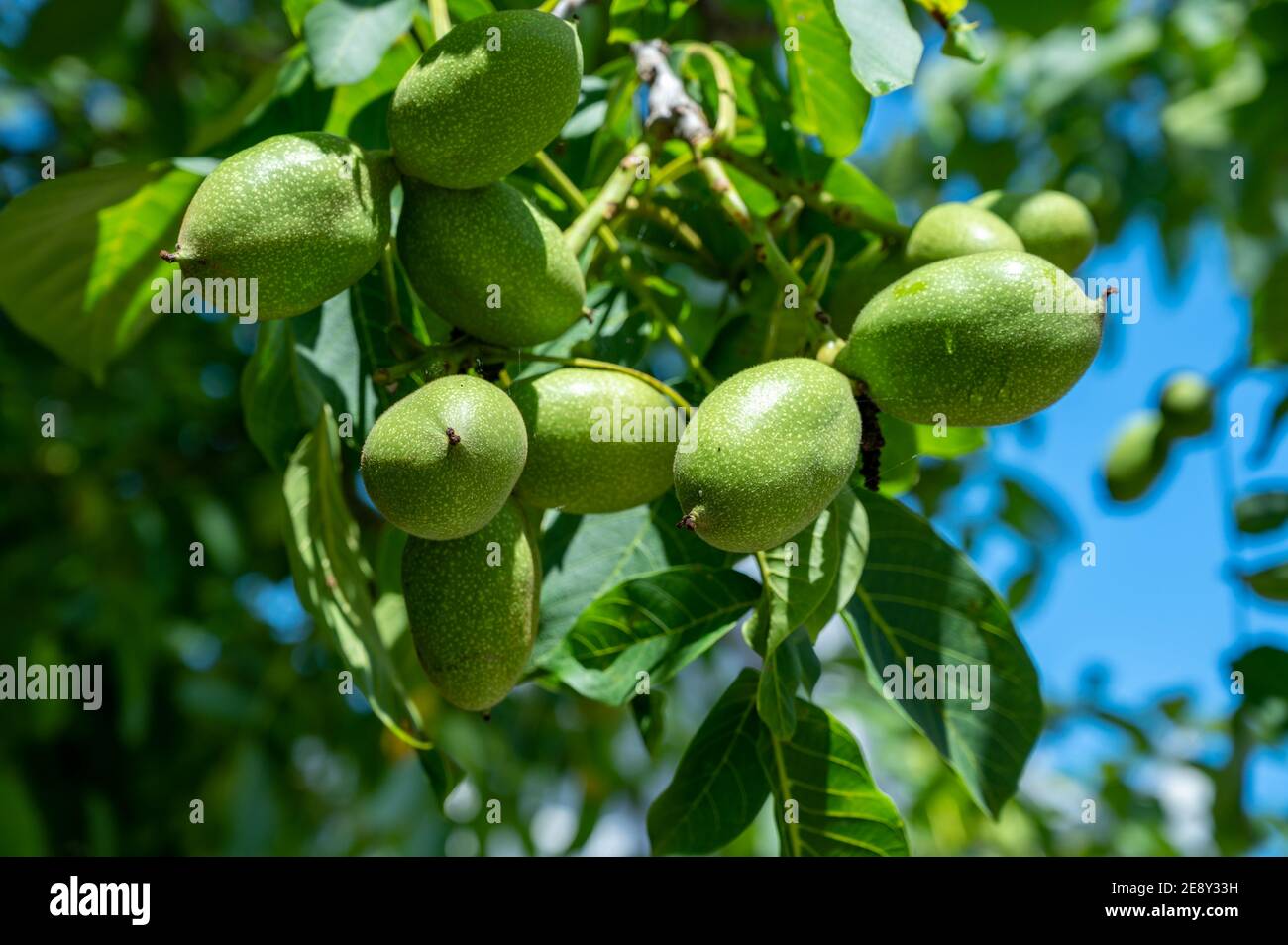
Special mention: Laney’s Hickory: Carya lineyi
Possibly the ultimate hickory nut, Laneys hickory is a cross between a shagbark and a bitternut.
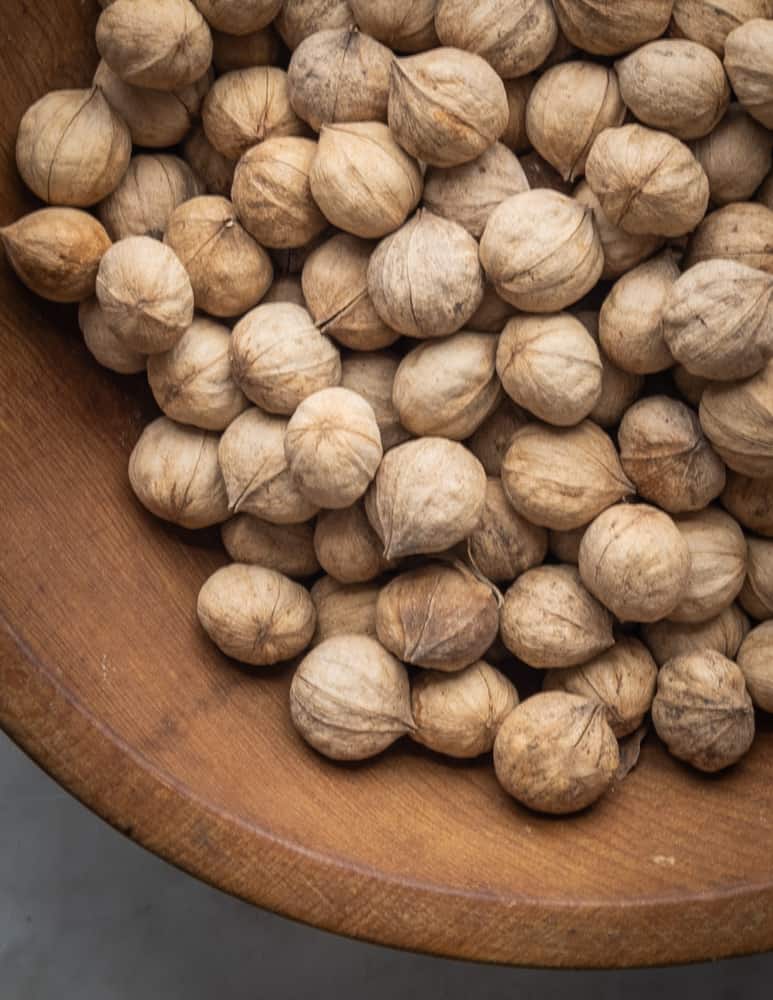
They have the thin shell of a bitternut hickory, but none of the bitterness. Theyre the best of both worlds. See the comparison below. Nature is fascinating!.
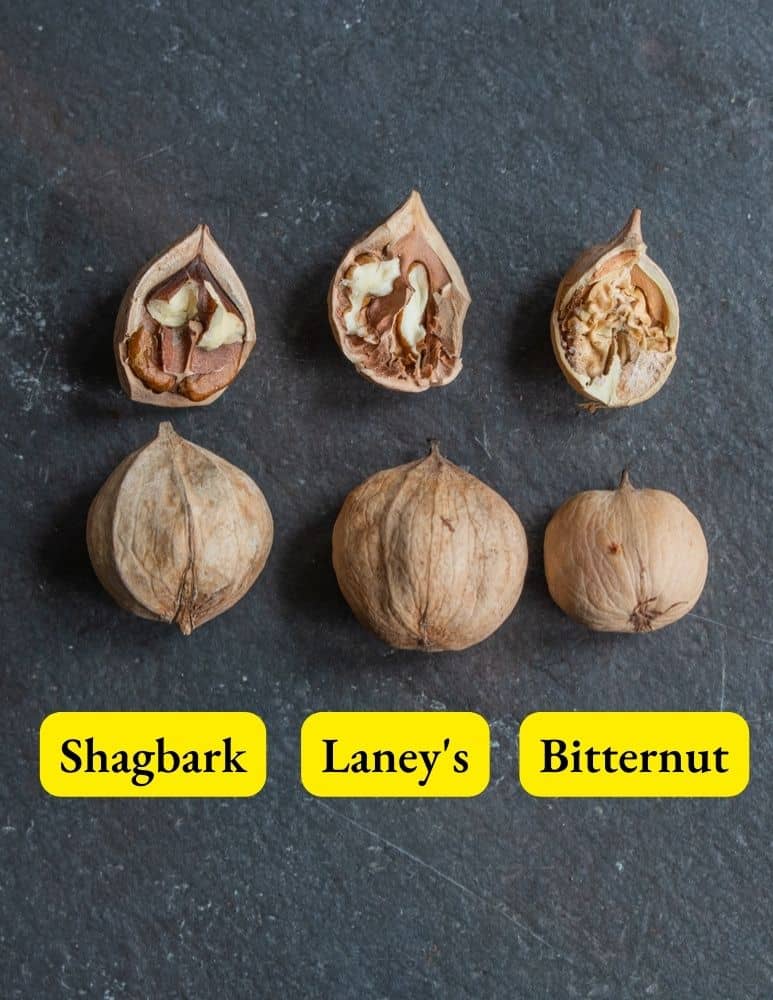
Shagbark hickory trees are one of the easiest trees to learn to identify. Heres a few quick tips.
- The bark is rough and covered in scales that are easy to break off. The easiest and fastest way for me to tell what kind of tree it is in the woods is to look for shaggy bark.
- At first glance, their compound leaves with six lobes look a lot like the leaves of black walnuts and butternuts, which are in the same family.
- Hickory trees stand straight up and have a single trunk. The ones you want are usually big.
- They stand out a lot where they get a lot of sun, like in the picture below. When I know they might be in an area, I may hunt them from my car with binoculars.
- The leaves are darker green than many other trees.
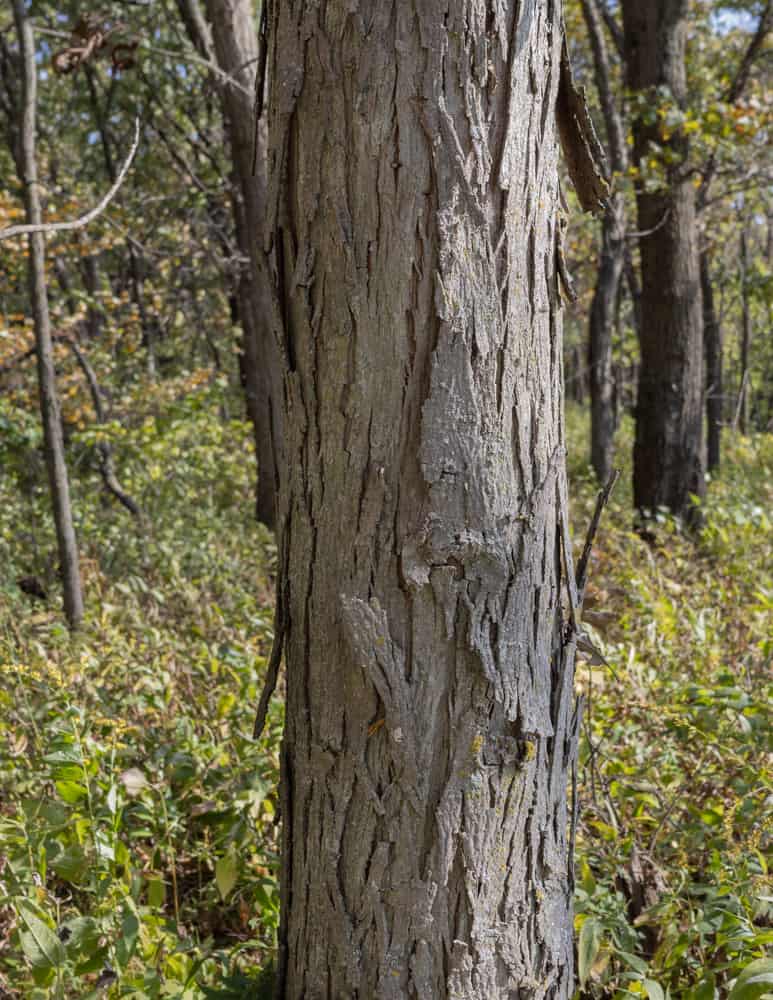
In order to get a good crop, youll need to find a good patch of nut trees. Really, I don’t check on hickory trees in the woods because they don’t get enough sun, so they won’t make as many nuts.
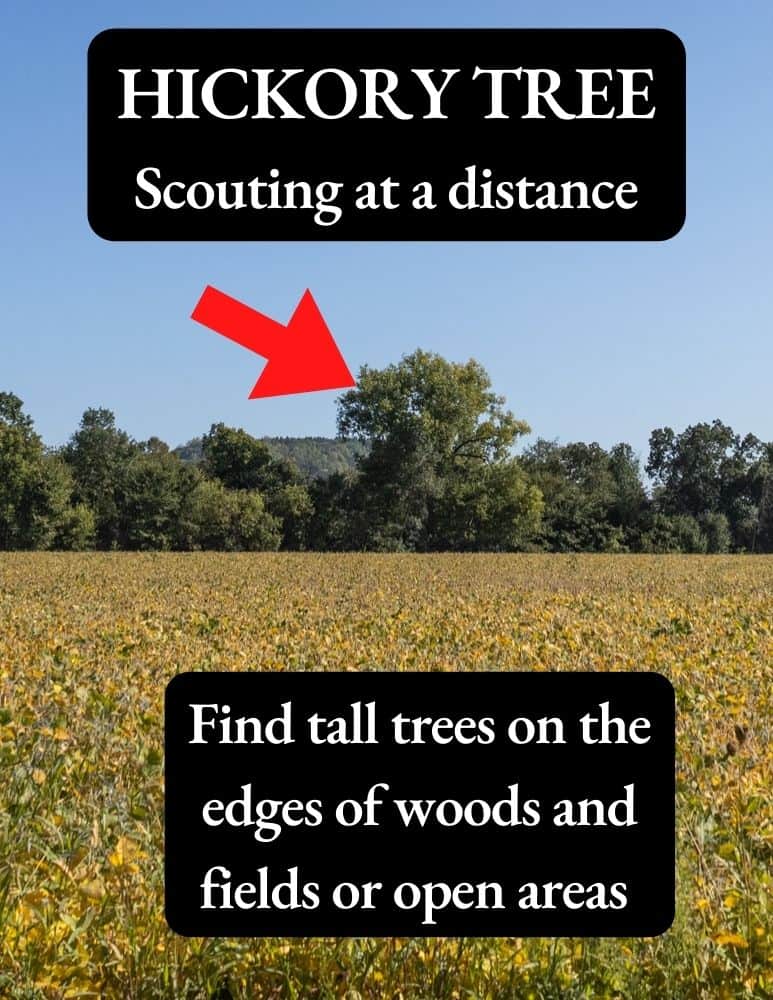
Squirrels and deer also get nuts in the woods faster than in open areas. Ideally, you want trees that get lots of sun, and are in a relatively open space. A tree in a friend or relatives yard is ideal.
Heres two other things I may look for depending on the location:
Scouting for masting trees
Like their cousins in the Juglandaceae family, black walnuts and butternuts, hickory trees produce nuts at different times. This is called a masting cycle.
Some years trees may not seem to make any nuts at all, and other years they will have a lot. Your job is to find trees that are masting, at the right place, at the right time.
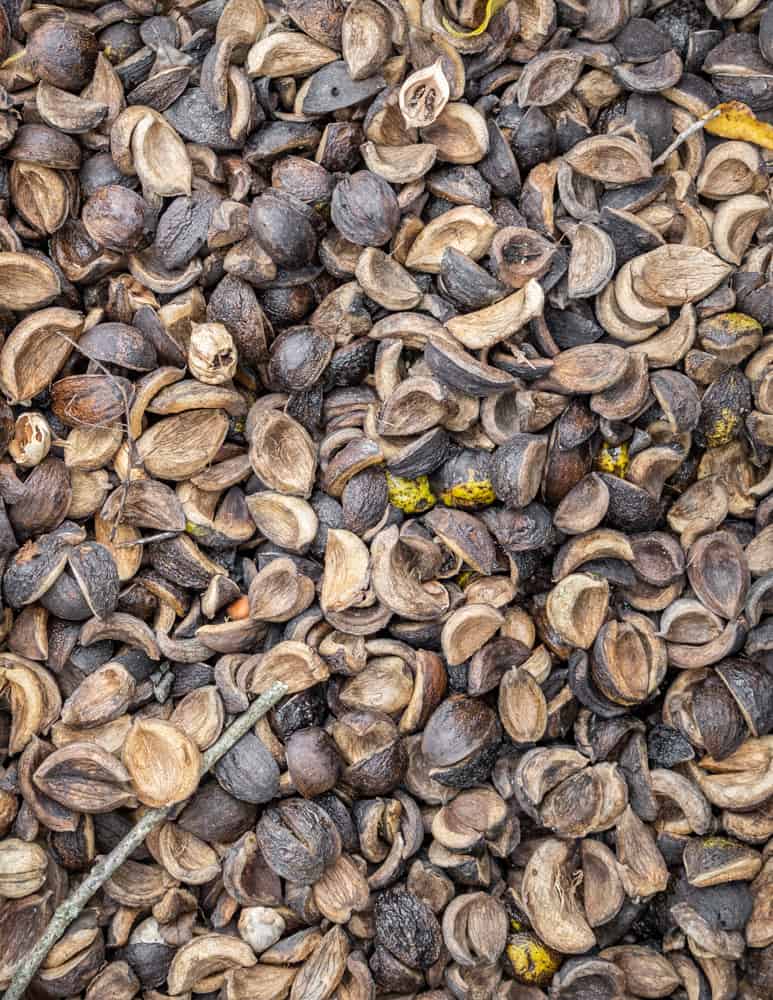
To hedge my bet, I often scout for nuts before theyre ready to drop. I take a pair of binoculars and go to my patches, scanning the canopy of the trees for nuts which will appear as yellow-green orbs on the branches.
When I find trees that seem to have a good crop, I set a reminder to come back in a few weeks when the nuts begin to drop.
I harvest hickory nuts mid-to-late September through October where I live, although Ive read they can start a month later in the south.
When I suspect the nuts are ready, I go to my patches Ive scouted. In a perfect world Ill see freshly dropped nuts still in their green outer husk as I walk through the woods, and Ill probably hear nuts falling from trees all around me as I pick.
Unlike black walnuts and butternuts, hickories wont stain your hands when harvesting so theres no need to wear gloves.
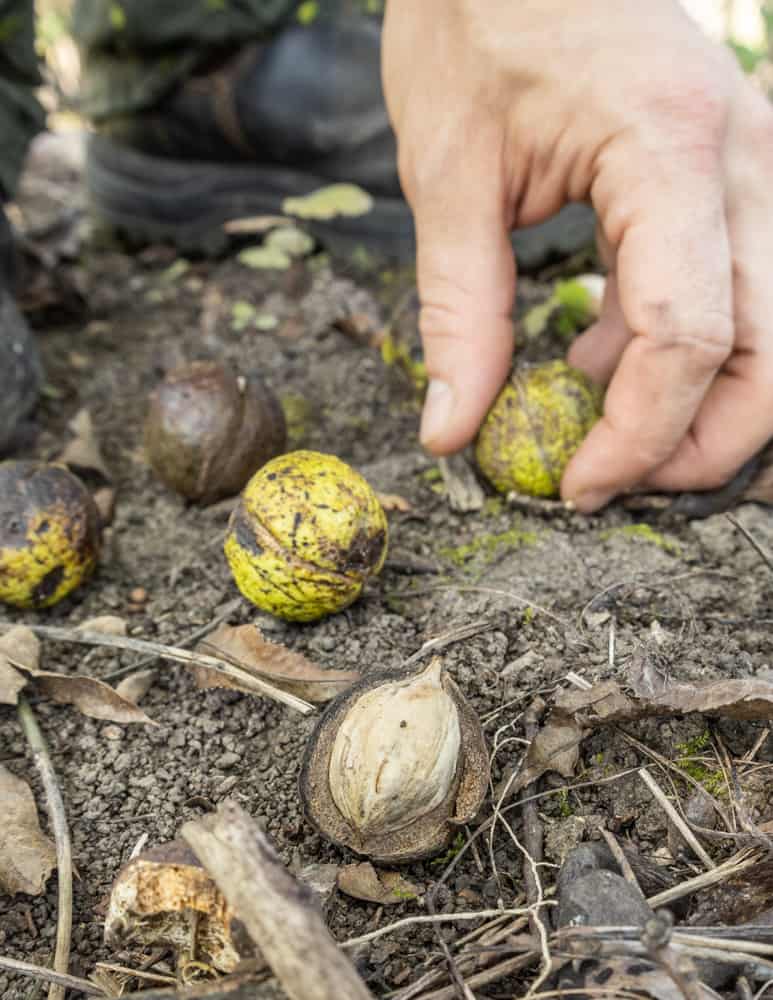
Some nuts will fall early-avoid all of these. Trees may reject nuts for a number of reasons, typically the ones I see that fall early are nuts that have been aborted for some reason, or those that have insect damage.
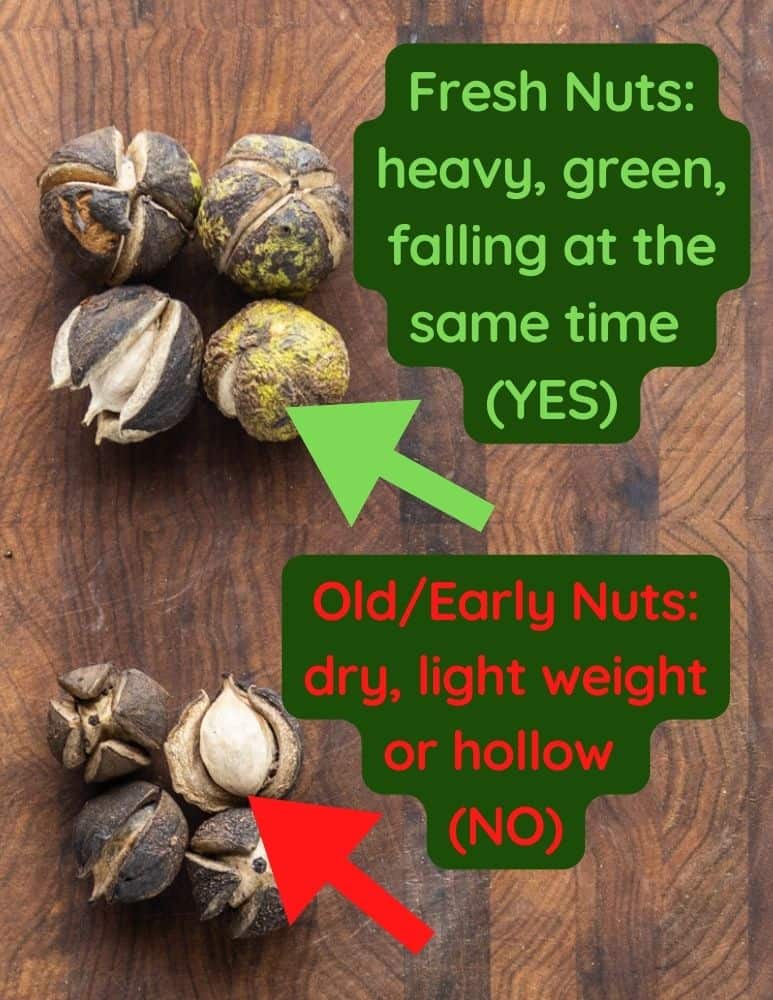
While youre harvesting, it can be tempting to pick up all the nuts you see, but you should resist the urge. Carefully inspect the nuts as you pick. Over time, you should be able to see the differences between freshly dropped nuts and those that may have dropped earlier and arent good for eating.
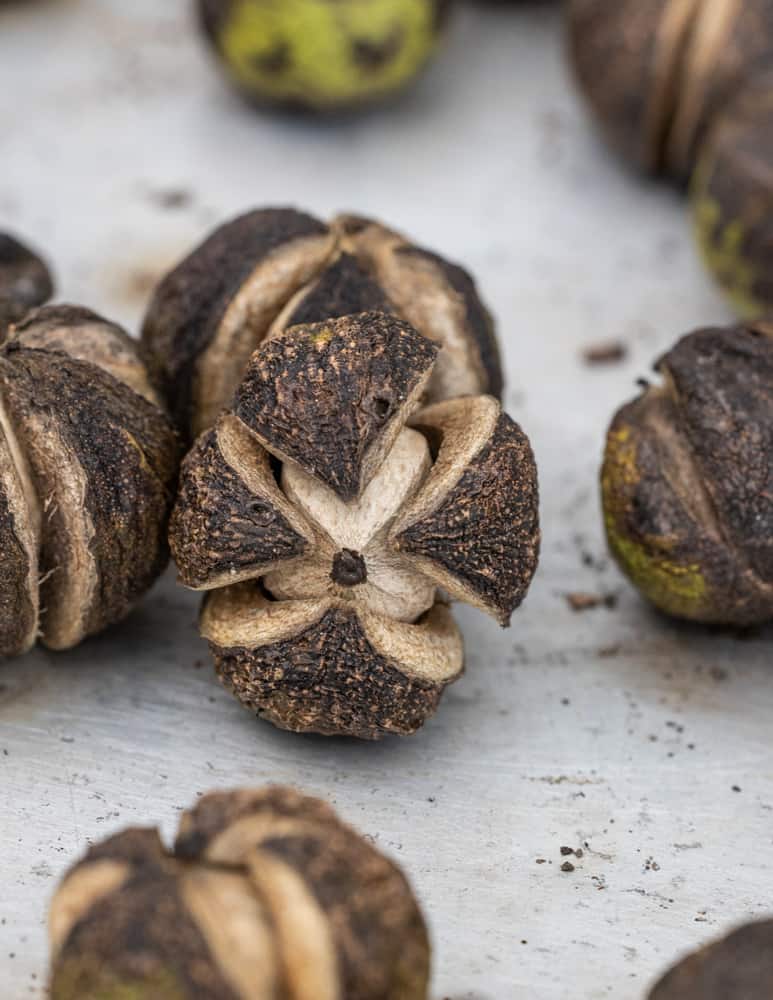
8 Nut Trees That Grow Well In USDA Zone 5
FAQ
What are the big green nuts from trees?
Definitely hickory nuts. Those don’t look ripe yet. When they are ripe, the outer green covering will come off easily, exposing the real nut inside. They are VERY hard to crack (I use a vice) and are a fair bit of work to get the meat out, but they taste amazing.
What tree drops green nuts?
Shagbark hickory nuts drop from the tree as a green orb the size of a golf ball. That orb is a thick husk.
What do shagbark hickory nuts taste like?
Shagbark hickory nuts have a flavor that is rich, buttery, and sweet. They are often compared to a mix of pecan and walnut, with a hint of maple. They are considered a delicacy and can be enjoyed raw, roasted, or used in various culinary applications.
Can you eat the nuts from a shagbark hickory tree?
Shagbarks have a thick husk and shell and taste good. Even so, newcomers often confuse the two, until they eat them. Bitternut hickories have a thin husk, thin shell, and bitter taste. They’re best pressed for oil or left for the deer and squirrels.
What is a good nut tree?
English Walnut (Juglans Regia) Picture a tree that adds a touch of elegance to your yard. English walnuts are favored for their mild, creamy nuts. These trees flourish in areas with mild winters and prefer loamy, well-drained soils. Regular care ensures a healthy and productive tree. 6. Heartnut (Juglans Ailantifolia Var. Cordiformis).
What are the different types of nut trees?
The most common nut tree types include pecan, hazelnut, almond, chestnut, cashew, pistachio, hickory, macadamia, pine nut, black walnut, English walnut, Brazil nut, butternut, oak nut (acorn), Pili nut, beech, and Ginkgo nut tree. Each of them has unique characteristics and features that can help you identify them among others.
Which Nut Tree Grows in South Africa?
The Mongongo Tree (Schinziophyton rautanenii) is endemic to southern Africa where its edible nuts are high in fat and protein and traditionally gathered. It tolerates drought and grows in sandy or rocky soils, providing an important local food and oil source. 27. The Sapucaia nut tree is native to South America.
What does a nut tree look like?
The leaves of nut trees are typically compound leaves, meaning that they are made up of multiple leaflets. The shape and arrangement of the leaflets can vary depending on the species of tree. The bark of nut trees is typically rough and scaly. Each type of tree has a different bark color, but most of the time it is brown or gray.
Are nut trees a good investment?
Putting up nut trees in your yard is a good idea because they will give you shade, beauty, and a healthy harvest for many years. These trees not only enhance your landscape but also offer a sustainable food source with minimal maintenance. Whether you have a large backyard or a small garden, there’s a nut tree suited to your space and climate.
What are the different types of nut tree bark?
Some common types of nut tree bark include: Smooth bark, such as that found on pecan trees. Pecan trees have smooth, gray bark that is often covered in lenticels. Scaly bark, such as that found on walnut trees. Walnut trees have scaly, brown bark that is often furrowed. Ridged bark, such as that found on hickory trees.
